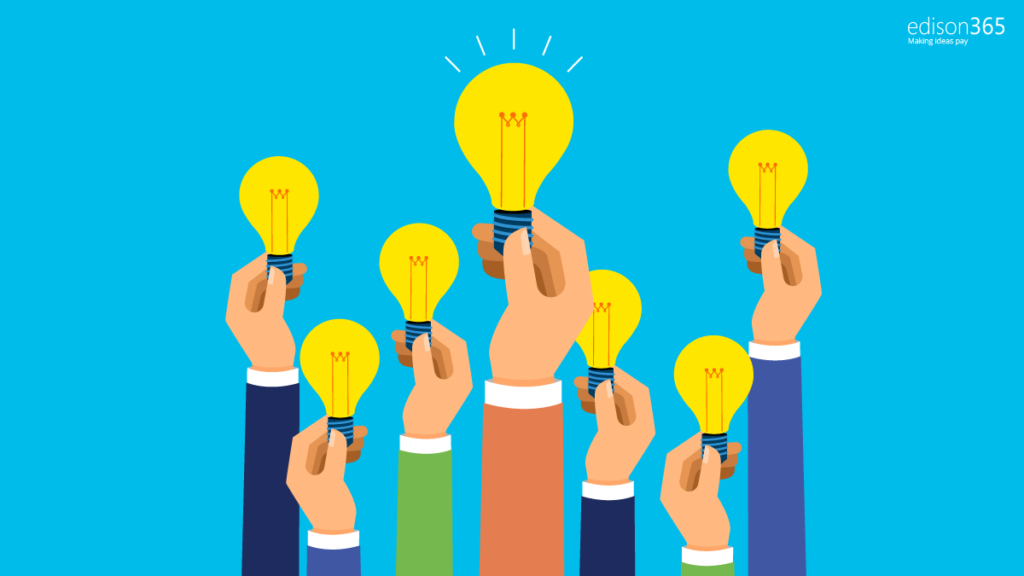As the name suggests, crowdsourcing is a method of generating ideas, opinions, or micro-tasks from a group or ‘crowd’ of people, often with a shared interest. For example, Google Maps relies on its users to report traffic collisions or provide information on public transportation, such as accessibility. Meanwhile, LEGO allows fans to submit and vote on ideas for new models and Zooniverse enables researchers around the world to tap into the data-crunching skills of ‘citizen scientists’. This blog explains ‘what is crowdsourcing’.
Usually, crowdsourcing is carried out online using websites, software tools (including idea crowdsourcing tools like edison365’s), or social media, but can include in-person events, such as hackathons.
It’s not to be confused with crowdfunding, where groups of people provide money to support a business idea or good cause.
A Short History of Crowdsourcing
Although the term ‘crowdsourcing’ is recent (allegedly it was coined in a Wired article by Jeff Howe during 2006), the concept has been around far longer.
In fact, one of the earliest examples of crowdsourcing comes from 1567, when King Philip II of Spain offered a cash prize for solving the issue of calculating the longitude of a vessel while at sea! This was followed by further prizes across the years, until the problem was finally cracked in 1773, following the offer of a reward by the UK government.
The next time you open a can of beans or soup, just remember that that’s down to Napoleon’s offer of 12,000 Francs to improve food preservation in 1795. The technique used by the winner, Nicolas François Appert, still forms the basis of canning techniques today.
Fast-forward to 1884 and over 800 volunteers cataloged words for the first version of the Oxford English Dictionary. An individual could not have carried out a task of this size, but a group of individuals passionate about language were able to.
But it was in more recent times, thanks to the advent of the internet, that crowdsourcing really took off. SETI@Home was set up by the University of California in 1999, where users could install a program that scanned for signs of extraterrestrial life whilst their computer was idling. Meanwhile, Wikipedia was launched to the world in 2001 – enabling individuals to contribute their knowledge to a global source of information.
What can crowdsourcing be used for?
Crowdsourcing has become such a part of everyday life that we barely notice it – from providing reviews on travel apps to voting for new products on social media.
In the business world, some potential uses of crowdsourcing include:
- Generating ideas
- Problem-solving
- Product development
- Engaging consumers
- Cost savings
- Software development
Employee crowdsourcing
Employee crowdsourcing enables companies to tap into the experience of people from across their business. So, rather than relying on a select group of individuals with a narrow view, the doors are opened wide, and companies can ask the opinions of a far more diverse group. It’s very much about appreciating the importance of intrapreneurship and collectively sourcing new ideas and opportunities. Rather than relying on leadership for new ideas.
For example, if you want to improve the processes within your manufacturing plan, why not ask the people carrying out those processes and creating your products?
According to Forbes, actively engaging individuals in crowdsourcing for innovation can improve employee engagement, as week as breaking up internal monopolies. This is especially important in the current climate, with 38% of the UK workforce looking to leave their jobs, as engagement improves employee retention.
The Advantages of Crowdsourcing
By using crowdsourcing to generate ideas, rather than more traditional techniques such as suggestion boxes, businesses can benefit from:
- Generating more ideas – having more heads considering a problem naturally results in a greater number of suggestions.
- Save on time and money – bringing people together digitally takes up fewer resources than having dedicated meetings and time set aside for ideation.
- Greater diversity – not just in terms of gender, race, and disability, but also diversity of personality, job roles, and thought. Having a wider range of viewpoints will provide you with a more holistic view of solutions to your business problems.
- Employee engagement – using collaborative idea crowdsourcing tools such as innovation management software enables you to tap into collaborative features, such as voting and gamification, which are designed to boost employee engagement. This, in turn, can give greater meaning to individuals’ work and improve retention.
Hackathons
While most examples of crowdsourcing take place virtually, another method of sourcing ideas from a group is hackathons. Although hackathons can take place online, most consist of in-person events that are dedicated to solving a specific challenge or create innovations.
They provide employers with a focused session for generating ideas from a specific group of individuals and give participants the chance to network, develop their skills and enjoy the challenge of solving a problem.
Discover more about employee crowdsourcing and idea crowdsourcing tools
Looking to tap into your teams’ ideas with employee crowdsourcing? Check out our articles on getting the most from ideas generation:
- What Makes a Good Idea?
- What Makes a Good Challenge?
- How do Hackathons Work?
- How to Organize a Successful Hackathon
We also have information on innovation management for specific industries, such as healthcare and construction.
FAQs: What is Crowdsourcing?
What is crowdsourcing and how does it work?
Crowdsourcing is a method of generating ideas, opinions, or micro-tasks from a group or ‘crowd’ of people. In the business world, crowdsourcing is often used for:
- Generating ideas
- Problem-solving
- Product development
- Engaging consumers
- Cost savings
- Software development.
What is an example of crowdsourcing?
A famous example of crowdsourcing is LEGO’s Ideas platform, which enables fans from around the world to submit their suggestions for new sets and vote on their favorites. Sets produced so far have included the International Space Station, Friends (Central Perk Coffee), and Van Gogh’s Starry Night. The Friends set was so popular that Lego has now brought out the iconic apartment as a follow-up.
Who invented crowdsourcing?
Crowdsourcing has been around for longer than you’d expect! The earliest example comes from 1567, when King Philip II of Spain offered a cash prize for solving the issue of calculating the longitude of a vessel while at sea! The term ‘crowdsourcing’ is more recent, however – allegedly it was coined in a Wired article by Jeff Howe during 2006.
Why is crowdsourcing so popular?
Organizations use crowdsourcing because it enables them to generate lots of ideas in short spaces of time, by reaching out to more people. This also means that they are able to solve problems by sourcing ideas from people with a greater diversity of experience, job roles, and viewpoints.
Using virtual idea crowdsourcing tools saves businesses time and money, as a virtual space takes up fewer resources than in-person meetings. It can also have the added effect of improving employee engagement by giving greater meaning to their work.




